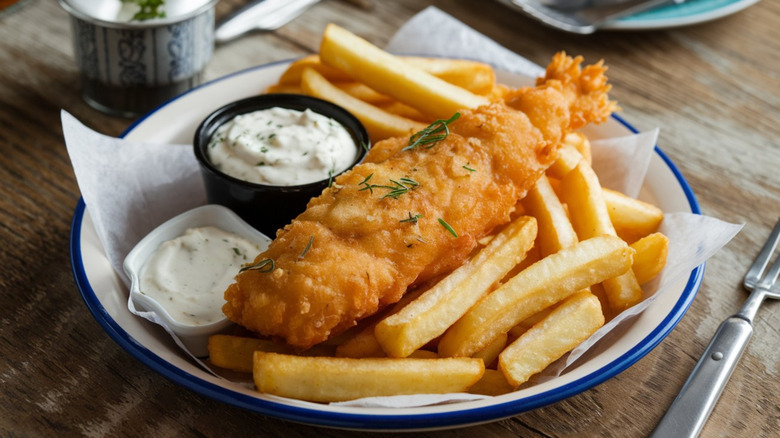Make Fish And Chips Like Gordon Ramsay With This Type Of Beer
Homey and comforting, crispy fish and chips owe their longstanding popularity in the U.K. to their simplicity. To make them, drench your fish (preferably cod or haddock) in batter, deep-fry until golden, then pair with pillowy, thick-cut fries. Though not a requirement, beer is commonly used in the batter mix. It makes for a light and crispy coating, as the carbonation creates air bubbles that expand during frying. As for the best beer to use, you'll inevitably get different answers depending on who you ask. So for inspiration, look no further than one of Britain's most celebrated chefs, Gordon Ramsay, whose recipe for the dish makes use of a classic light beer: lager.
Lager is a sub-category of beer whose uniqueness lies in its fermentation process. Lager utilizes a yeast that prefers cooler temperatures and tends to settle at the bottom of the fermenter. The resulting taste is described as lighter, cleaner, and crisper than other types of beer, which undergo warmer, top-fermentation to produce a heavier, fruitier taste. Popular brands of lager include Budweiser and Heineken.
It's not only Ramsay who enjoys a lager-based beer batter — it's commonly used by many fish and chips vendors. The beer's light, crispy texture adds a refreshing bite to an otherwise heavier dish, pairing well with the delicate white fish and balancing out the strong, savory notes of the malt vinegar and salty fries.
Other types of beer for fish and chips
To add beer to your batter, simply combine the flour, baking soda, salt, and pepper, and mix slowly — whisking in the beer. To ensure your fried fish comes out as crispy as possible, pat your fillets dry before putting them in the batter, use cold beer, and allow the batter to rest so the gluten can relax.
Most beers, from the lightest ales to the darkest malts, contain carbonation that produces a crispy batter. The main differences in what you choose lie in flavor. For light, mild flavors, the obvious choice is a lager or light beer. But if you want a richer taste, look no further than ale. Ale differs from lager as it's top-fermented at warmer temperatures. This produces richer and more complex flavor notes, such as hoppy or bitter. For the best balance of flavor between the fish and beer, opt for a pale ale, which has a more subtle flavor than maltier dark ales like Guinness. We recommend avoiding pale ales with high hop content, like many IPAs, as the bitterness can overpower your batter.
For those avoiding alcohol, there are still plenty of options that deliver a shatteringly crisp batter. Non-alcoholic beers are particularly good substitutes, and some brands undergo full brewing with the alcohol being removed afterward. This means they'll offer the same flavors and carbonation to produce crispy, delicious results. Sparking water or club soda are also excellent non-alcoholic options. While comparatively neutral in flavor compared to beer, they'll allow the fish's natural taste to shine.


